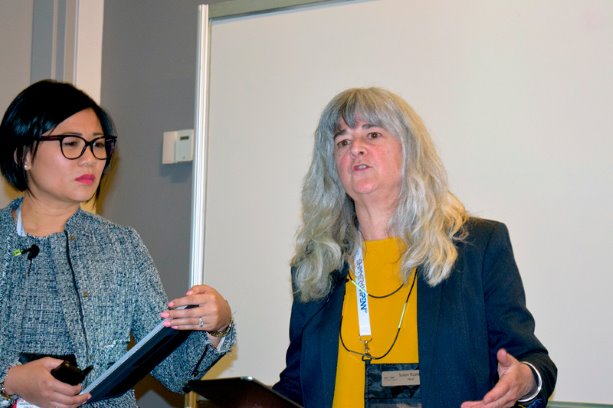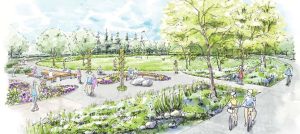Ontario accessibility regulations and building code standards represent the bare minimum that architects should follow in building for accessibility, said two advocates for the concept of universal design who spoke at the recent Royal Architectural Institute of Canada conference held in Ottawa.
The last round of national building code consultations codified in 2016 was billed as the accessibility round but it fell way short, said architect Susan Ruptash of Quadrangle Architects, who with colleague Lorene Casiez offered a presentation billed as The Past, Present and Future of Accessible Architecture on May 26.
Ruptash urged the architects in attendance to look instead to Scandinavia, where universal design — a concept that was called a significant step up from mere barrier-free or accessibility — has been the practice for decades, and to the standards established by design pioneer Ron Mace in 1997 and revised in 2012 by Steinfeld and Maisel, authors of the book Universal Design: Creating Inclusive Environments.
Mace, of North Carolina State University, defined universal design as "the design of products and environments to be usable by all people, to the greatest extent possible, without the need for adaptation or specialized design."
That conception of universal design contained seven principles: equitable use, flexibility in use, simple and intuitive, with perceptible information, tolerance for error, low physical effort, and adequate size and space for approach and use.
"The early part of my career I spent a lot of my energy, ‘the codes need to come up way higher, the codes are inadequate,’ and then I realized they would never get there," said Ruptash, whose practice at Quadrangle includes contributing to the website accessibilityadvantage.ca, a joint venture of the March of Dimes Canada and Quadrangle. "The examples, the stuff we did in our studio, would be impossible to embed into a code, so I now look at codes as a base minimum. We consider building to code to be completely inadequate, but there are some people who would go lower if they could, so we need the code as a bare minimum for non-believers."
Ontario is one of four provinces in Canada with targeted accessibility legislation, with guidance for designers found in the Integrated Accessibility Standards Regulation, the Ontario Building Code and the Ontario Human Rights Code. Besides her own firm Quadrangle, with its accessibility division that includes registered nurse Casiez on staff, Ruptash said Geoff Fernie at the Toronto Rehabilitation Institute and Jutta Treviranus at OCAD’s Inclusive Design Research Centre are among Ontario design advocates championing higher standards.
A typical issue, explained Ruptash and Casiez, is how wide to build a turning circle for a scooter or wheelchair. They presented research that indicates with a turning circle radius of 2,100 millimetres, 95 per cent of manual and power wheelchairs can make the turn but only 50 per cent of scooters can. With a turning circle of 2,500 millimetres, there is 95 per cent accessibility for all three modes of travel.
"What we are talking about is kind of lofty ideas, but we have proven them as well," said Ruptash.
"It’s a social choice. We get pushback on turning circles. Someone will say, how big does it have to be? So sometimes cheekily, we’ll say, that’s fine, what percentage of people who use wheelchairs would you like to exclude? And that becomes a value judgment."
The issue will assume more importance as more boomers become older seniors. Statistics Canada research indicates that for people aged 75 and older, around 45 per cent of females and 40 per cent of males report a disability.
In the view of advocates like Ruptash, every space should reflect an attitude of inclusivity. Projects such as Quadrangle’s new studio on King Street West in Toronto and its award-winning build at 100 Broadview Avenue in Toronto make the owners more attractive for potential hires with their embracing of such features info graphics for wayfinding, big sliding doors that suggest openness to all and flexible lighting to accommodate different preferences, said Ruptash.
"We are seeing more interest but it is still new on people’s radar," said Ruptash. "People still see accessible design as a burden. An extra layer of requirements, extra space, they see the negative parts of it, but we have seen on several projects the actual power of it."
Clients expect universal design features will cost money, but Ruptash said that does not have to be the case.
"As designers, when we are starting at the beginning of a project, we are making constant decisions, we are making value judgments all the time," she said. "And if you just come embedded with the notion of having more circulation space for mobility devices or allocating space for a large universal toilet room, it just becomes a basis part of your design, and whatever your parameters are, however many people you need to fit in that space, you can do it.
"That will mean other decisions. In our studio, we made the choice to make our work stations a little smaller and added collaborative spaces to offset that, and that’s what gave us wider movement spaces, and we actually increased the density from our old offices and made it far more accessible."
Said Ruptash, "Universal design is just good design."











Recent Comments
comments for this post are closed